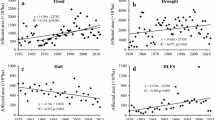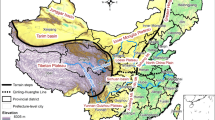Abstract
According to the statistics and collation of data on the main hydrological disasters that occurred in Urumqi from 1949 to 2015, the risk characteristics of the main hydrological disasters in the city are identified and analyzed to reveal the distribution of local hydrological hazard risk based on the comprehensive disaster risk assessment theory for historical disasters. The research findings are as follows: (1) the main hydrological disasters in Urumqi are caused by floods, snow, and droughts, among which floods have the greatest risk, while the risk of droughts is minimal. (2) There are various and complex types of flood disasters in Urumqi, which have frequent occurrences, a wide range of influence, and easily cause secondary disasters. Snow disasters are complex and diverse, with frequent occurrences. Moreover, there are varied and complex types of drought disasters in Urumqi, which have frequent occurrences. Drought disasters in Urumqi, which last for a long time, have enormous effects on agricultural and forestry crops, while the frequencies of frost and hail disasters in Urumqi are lower. (3) Historical hydrological disasters in Urumqi mainly occurred from May to August and November to March of the following year, which are high-frequency months for hydrological disasters. (4) Flood disasters in Urumqi occur every 1.59 years, on average, while snow disasters in Urumqi occur every 1.65 years, on average. Additionally, flood and snow disasters could easily occur in the next 15 years. (5) The hydrological disaster environment in Urumqi is mainly affected by local temperature, sunshine, elevation, topography, precipitation, plant resources, and the social economy.




Similar content being viewed by others
Notes
According to the Statistical Bulletin of the Urumqi National Economy and Social Development 2015
References
Chen YN, Yang SQ (1999) Application of grey clustering analysis in the classification of flood disaster grade. Arid Land Geography 3:37–42 (in Chinese)
Crimp SJ, Zheng B, Khimashia N, Gobbett DL, Chapman S, Howden M, Nicholls N (2016) Recent changes in southern Australian frost occurrence: implications for wheat production risk. Crop Pasture Sci 67(8):801. https://doi.org/10.1071/cp16056
Frederiks TM, Christopher JT, Sutherland MW, Borrell AK (2015) Post-head-emergence frost in wheat and barley: defining the problem, assessing the damage, and identifying resistance. J Exp Bot 66(12):3487–3498. https://doi.org/10.1093/jxb/erv088
Gong YB, Hu N, Liu GF, Feng LP (2016) Risk evaluation model of flood and drought disaster based on normal cloud information diffusion method: a case study in Xuzhou City. Syst Eng 34(11):54–58
Gu LS (2009) Research on the development of international disaster reduction policy. Disasters Reduct China 7:5–8 (in Chinese)
Han BH, Wu R, Zhou BR, Xiao L, Niu DC, Fu H (2017) Grid-based estimation of snow disaster risk in Qinghai Province. Arid Zone Res 34(5):1035–1041
Jiang FQ, Hu RJ, Yang YH (2004) Abrupt change in the time sequences of flood disasters in Xinjiang and its possible climatic reasons. J Glaciol Geocryol 6:674–681
Li XS (2013) Changing characteristics of snowfall in Xinjiang from 1961 to 2010. Northwest Normal University, Lanzhou, pp 35–36 (in Chinese)
Li XW, Sun Z, Sun GL, Zhao W, Wang T (2016) Influence of hail disaster on fruit trees in Aksu prefecture. J Agric Catastrophology 6(8):32–35 (in Chinese)
Liu ZH (2009) The prediction, early-warning for snowmelt flood and decision support based on ‘3S’Technologies in Xinjiang. China University of Mining and Technology, Beijing, pp 66–67 (in Chinese)
Liu DH, Zhang SS (2017) Flood risk assessment based on entropy AHP and D number theory. Stat Decis 20:52–55 (in Chinese)
Liu YP, Wang SP, Wang JS, Wang ZL (2018) Risk assessment of drought disaster in Southwest China under the background of climate warming. J Nat Resour 33(2):325–336
Lou W, Sun K, Sun S, Ma F, Wang D (2013) Changes in pick beginning date and frost damage risk of tea tree in Longjing tea-producing area. Theor Appl Climatol 114(1–2):115–123. https://doi.org/10.1007/s00704-012-0825-5
Mishra AK, Singh VP (2010) A review of drought concepts. J Hydrol 391(1):202–216
Nakai S, Sato T, Sato A, Hirashima H, Nemoto M, Motoyoshi H, Ishizaka M (2012) A snow disaster forecasting system (SDFS) constructed from field observations and laboratory experiments. Cold Reg Sci Technol 70:53–61. https://doi.org/10.1016/j.coldregions.2011.09.002
Punge HJ, Kunz M (2016) Hail observations and hailstorm characteristics in Europe: a review. Atmos Res 176-177:159–184. https://doi.org/10.1016/j.atmosres.2016.02.012
Randeniya E (2018) Flooding disaster: the effect on the adolescents at Angoda Rahula College, Sri Lanka. Procedia Eng 212:723–728. https://doi.org/10.1016/j.proeng.2018.01.093
Shi LM, Zhao ZP, Wang X (2015) Temporal and spatial distribution features of hail disaster in Xinjiang from 1961 to 2014. J Glaciol Geocryol 37(4):898–904
Shi LM, Li B, Li YY, Kong LW, Liu WP (2017) Study on economic loss assessment and risk division of hail disaster in Xinjiang. J Glaciol Geocryol 39(2):299–307 (in Chinese)
Song HL, Wan HL, Zhu CC (2018) Research on frost disaster events and effects in Shaanxi region for the past 1400 years. J Arid Land Resour Environ 32(4):170–176
Sun JH, Chu GQ, Liu XY (2008) Fire risk and insurance. Science Publishing House, Beijing, pp 36–41 (in Chinese)
Sun G, Chen Y, Li W, Pan C, Li J, Yang Y (2012) Intra-annual distribution and decadal change in extreme hydrological events in Xinjiang, Northwestern China. Nat Hazards 70(1):119–133. https://doi.org/10.1007/s11069-012-0242-1
Sun G, Chen Y, Li W, Pan C, Li J, Yang Y (2013) Spatial distribution of the extreme hydrological events in Xinjiang, north-west of China. Nat Hazards 67(2):483–495. https://doi.org/10.1007/s11069-013-0574-5
Sun YY, Yang QS, Chen P, Zhang JQ, Zhang LF, Du JT (2016a) System dynamic model for the snow disaster emergency rescue in prairie areas. J Arid Land Resour Environ 30(6):108–114
Sun Z, Li XW, Sun GL, Wang T, Zhao W (2016b) Risk assessment of main hydrological disaster of fruit trees in Aksu prefecture of Xinjiang. Agric Sci J Yanbian Univ 38(3):242–247 (in Chinese)
United Nations International Strategy for Disaster Reduction (2017) Sendai Framework for Disaster Risk Reduction 2015–2030. http://www.unisdr.org/files/43291_sendaiframeworkfordrren.pdf
Wan HL, Song HL, Zhu CC, Liu DY (2017) Analysis of hail disasters and its spatial and temporal distribution characteristics in Shaanxi region from 1368 to 2013. J Arid Land Resour Environ 31(2):123–127
Wang QX, Cui CX, Yao YL (2008) Variation trends and multi-scale analysis of flood affected area in various regions of Xinjiang. Acta Geograph Sin 7:769–779
Wang GH, Miu QL, Song J (2012) Risk regionalization of meteorological disasters in Hangzhou. China Meteorological Press, Beijing, pp 17–18 (in Chinese)
Watanabe T, Cullmann J, Pathak CS, Turunen M, Emami K, Ghinassi G, Siddiqi Y (2017) Management of climatic extremes with focus on floods and droughts in agriculture. Irrig Drain 67(1):29–42. https://doi.org/10.1002/ird.2204
Wen Y (2017) Building a beautiful China and striving to move towards a new era of ecological civilization. People’s Daily. http://paper.people.com.cn/rmrb/html/2017-09/30/nw.D110000renmrb_20170930_1-06.htm (in Chinese)
Wilhite DA (2005) Drought and water crises: science, technology, and management issues. CRC Press, Boca Raton, pp 234–237
Woodruff JM (2005) Consequence and likelihood in risk estimation: a matter of balance in UK health and safety risk assessment practice. Saf Sci 43(5–6):345–353. https://doi.org/10.1016/j.ssci.2005.07.003
Wu H, Hayes MJ, Weiss A, Hu Q (2001) An evaluation of the Standardized Precipitation Index, the China-Z index and the statistical Z-score. Int J Climatol 21(6):745–758. https://doi.org/10.1002/joc.658
Wu MH, Wang HJ, Sun GL, Xu CC (2016) Formation and risk analysis of meteorological disasters in Xinjiang. Arid Land Geogr 39(6):1212–1220
Xiang MY, Fan LH, Haimiti Y, He Q (2007) Study on the change of meteorological disasters and the prevention measures in Xinjiang since recent 45 years. Arid Zone Res 24(5):712–716
Xinhua News Agency (2017) Full text of Xi Jinping’s report at 19th CPC National Congress. http://www.chinadaily.com.cn/m/shandong/yantai/2017-11/04/content_34175088.htm (in Chinese)
Xinhua News Agency (2018) Institutional Reform Plan of the State Council. http://www.gov.cn/xinwen/2018-03/17/content_5275116.htm (in Chinese)
Xu JH, Shu H, Liu Y (2014) Spatio-temporal autocorrelation of snow disasters in Xinjiang from 2000 to 2010. J Catastrophology 29(1):221–227
Yang SQ, Chen YN (1999) Classification of disaster loss based on the fuzzy pattern recognition theory. J Nat Dis 2:56–60
Yang Y, Zhang L, Chen YY, Zhai YJ, Li HY (2017) Studing on the time characteristic of spring frost for wine grape in the east foot area of Helan Mountain in Ningxia. J Nat Dis 26(4):84–90
Yao XH, Wan X, Jia JY, Xu YP (2016) On climatic risk zoning of peach in flowering and fruiting period in Tianshui City. J Southwest China Normal Univ (Natural Science Edition) 41(7):144–150
Ye MQ, Chen BH (1996) Research on natural disaster zoning in Xinjiang. J Nat Dis 1:14–21
Ye LM, Zhou YH, Xiang H, Niu B, Gao W, Zhou Y (2016) Risk regionalization of urban roads waterlogging disasters based on GIS rainstorm flood inundation model. Resour Environ Yangtze Basin 25(6):1002–1008
Yin YY, Zhao JT, Wang JA (2013) Risk regionalization of hail disaster for cotton of Anhui Province. Resour Environ Yangtze Basin 22(7):958–964
Zhang Q, Zhang J, Wang C (2017) Risk assessment of drought disaster in typical area of corn cultivation in China. Theor Appl Climatol 128(3–4):533–540. https://doi.org/10.1007/s00704-015-1723-4
Zhao J, Jin J, Xu J, Guo Q, Hang Q, Chen Y (2018) Risk assessment of flood disaster and forewarning model at different spatial-temporal scales. Theor Appl Climatol 132(3–4):791–808. https://doi.org/10.1007/s00704-017-2086-9
Zheng YP, Gong HR, Cao X, Pu J (2015) Characteristics of frost in the agricultural area in Urumqi during 1961-2013. Desert Oasis Meteorol 9(1):52–57
Zhu F (2011) Evaluation of social vulnerability to natural disasters of Xinjiang. Chongqing Normal University, Chongqing, pp 56–57 (in Chinese)
Funding
This work was supported by the Special Funds of the National Social Science Fund of China (18VSJ038) and supported in part by the National Science Foundation of China (under grant 71471076).
Author information
Authors and Affiliations
Corresponding author
Ethics declarations
Conflict of interest
The authors declare that they have no conflicts of interest.
Rights and permissions
About this article
Cite this article
Li, X., Du, J., Long, H. et al. Characteristics and risk analysis of hydrological disaster events from 1949 to 2015 in Urumqi, China. Theor Appl Climatol 137, 745–754 (2019). https://doi.org/10.1007/s00704-018-2630-2
Received:
Accepted:
Published:
Issue Date:
DOI: https://doi.org/10.1007/s00704-018-2630-2




